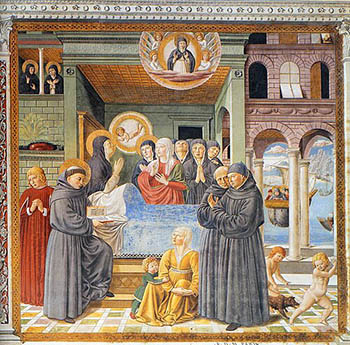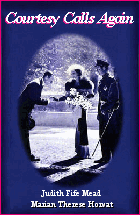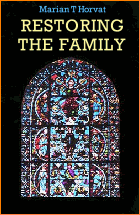Book reviews
 |
 |
 |
 |
 |
 |
 |
An Uninspiring Presentation
of the Great St. Monica
Review of Saint Monica: Model of Christian Mothers, by F.A. Forbes, TAN, 1998, 120 pp.

I would recommend this work more for young adults as I found it too simplistic for an adult and too difficult for its targeted audience of children, especially with its unexplained historical references (to Hannibal, Carthage, the Church’s “early long imprisonment”, etc). The illustrations in it I found too sugary sweet for any audience.
One thing is certain: St. Monica was an extraordinary woman. Since one cannot separate her name from that of her famous and eldest son, St. Augustine, the book contains a lot of information about his life as well. She did have two other children, a daughter named Perpetua, who is only briefly mentioned: she married and then entered a convent after her husband's death. Her other son Navigius also married, but he later lived with Augustine and Monica (other reliable sources report he became a monk). These little “slips” reveal the somewhat superficial spirit of the work. Even though it was written for children, it should be reliable.
Monica was married at age 22 years to a pagan named Patricius who was of a noble family but poor. He was also nearly twice her age and had a violent temper, to which his wife was often subjected. His widowed mother was part of the household, and she controlled its running instead of passing on the duties to the wife as was customary. She resented Monica and made her life a misery.
The household slaves took their cue from the jealous mother and would please her by relating wicked false stories about Monica, who bore all with patience. Faithful in prayer and constant in supplication, she stalwartly bore the violence of her husband's wrath, the lies, shouting, and abuse of her mother-in-law and servants with amazing fortitude.

St. Augustine & St. Monica
At age seven, Augustine began formal school in Tagaste, where they lived. It was a pagan school, and he was a poor student because he disliked discipline and work. He began showing his genius after some years, though he also was influenced for ill by his pagan companions. At 14 he was sent to Madaura, a city large enough to host a circus, theater and forum, and boasting impressive statues of various false gods. Here he lost his childish innocence and began participating in evil deeds.
Although St. Augustine had a lower-class concubine with whom he lived for 15 years (whose name is unknown), no mention is made of her. They had a son, Adeodatus, who is also not mentioned. Not included as well was one of my favorite sayings of Augustine, uttered by him repeatedly, "Oh Lord, give me chastity and continence, but not just yet," which was his plea during this period of his life.
He knew the relationship was sinful but was attached to it and struggled mightily to relinquish it. His concubine eventually died, and their son died at age 17 when Augustine was 36. His conversion is a moving story, but is not told here.
It was shortly after this that the famous voice commanded him, "Tolle, lege; tolle, lege" (take up and read). This was the turning point for him, and he not only became a Catholic but dedicated his life to Christ. His mother's prayers had been answered, as they had when his father embraced the Faith along with her mother-in-law and the servants, who were all won over by St. Monica’s selfless acts of love and humbleness.
St. Monica joined Augustine and his companions, along with her younger son, in forming a household after her husband had died. She traveled with him when he moved and acted as mother to all the young men.

The Death of St. Monica, by Benozzo Gozzoli
She was buried in Ostia, as she had foretold. In 1453 Pope Martin V moved her sacred relics to the Church of St. Augustine in Rome.
In California the city of Santa Monica has connections to the mother of St. Augustine. When the early Franciscan missionary Fr. Juan Crespí saw a pair of springs along the border of what is now Santa Monica, he named them The Tears of Saint Monica because they reminded him of the tears the Saint shed for her son’s conversion. The mission town later took the name Santa Monica.
I ordered the book as a gift for a friend who was getting confirmed. It was a Novus Ordo confirmation, and the confirmants had to use their middle names; her middle name is Monica. I was flabbergasted at that. I do not have a middle name. Would I have been refused Confirmation?
Today we need all the help we can get from the saints, and another patron, chosen because of a special bond that connects the saint to the confirmant – can only be for our advantage. Also, the Bishop omitted giving the slap on the cheek, which signifies the confirmant becomes a soldier of Christ and his willingness to suffer for the Faith.
The book seems popular and is available through many outlets. It is a mediocre book, short, easy to read, but to me very romanticized and not compelling, although it does give one an appreciation of St. Monica's perseverance and fidelity to prayer.

St. Ambrose to St. Monica:
‘The son of so many tears cannot be lost’
Posted November 14, 2025

______________________








